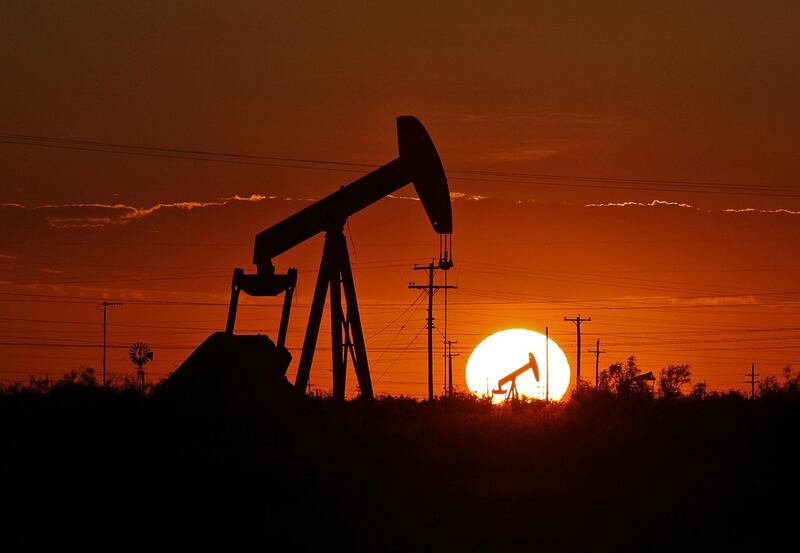The foxtrot and the Dust Bowl may be history but one thing from 1930s America may be making a comeback – oil over-production. This takes us back to 1933, the battle against “hot oil”, and the inspiration for Opec.
As today, Texan oil output was booming in the early 1930s, because of the discovery of the giant East Texas field and had soared to over 1 million barrels per day, more than a third of the US total. Unlike today, oil demand was weak because of the Great Depression, and prices had fallen to $10 (Dh36.72) per barrel in today’s money. After bitter legislative battles, the Texas Railroad Commission (RRC) obtained the power to regulate the state’s production, and to coordinate with other states to prevent illegally overproduced oil from being transported.
The RRC set maximum production rates for each well or area. Texas, like Saudi Arabia today, thus provided a “swing” capacity, increasing or decreasing production to fill market gaps and maintain stable prices. From the 1950s through to the early 1970s, it was joined internationally by the “Seven Sisters” of major oil companies, who collaborated to limit output from their joint ventures in Iran, Iraq and the Arabian Gulf countries.
This system endured until March 1972, when the growing maturity of fields in Texas meant the RRC allowed companies to produce at their maximum rate. The state’s oil output was 3.45 million barrels a day – a historic annual high it would never reach again.
Until, that is, 2017. Spurred by the shale boom in the Permian basin of west Texas, production, barely above 1 million barrels per day as recently as 2010, has soared to just short of 5 million bpd, more than any country except Russia and Saudi Arabia.
Yet the financial returns of shale oil and service firms remain poor. That spurred a respondent to an industry survey by the Dallas Fed to say: “We need to start a conversation between industry and government about bringing back pro-rationing (daily production allowables and monthly market factors) again. Nobody’s generating free cash flow.”
Texas is not the first to remember this idea. The main oil-producing Canadian province of Alberta introduced mandatory quotas from January, though there the problem has been a lack of pipeline export capacity, leading to a crash in the wellhead prices producers receive.
A per-well cap would not work for shale, given the short lifetime of fracked wells and their low production rate after the first year or so. As Alberta did, a limitation could be applied on total production per company, based on their historic levels, or perhaps on the amount of drilling. But it would be a drastic step, likely to be opposed by most of the industry and not supported by other oil-producing states.
The mere fact that such radical, non-market approaches are being proposed shows the frustration of shale companies. Since the lowest recent oil price in January 2016, US light crude has almost doubled from $29.42 to $56.2 per barrel, and Permian basin production has also doubled from 2 to 4 million bpd.
But despite this quadrupling of gross revenues, shale producers have been unloved by investors. The shares of Occidental Petroleum, one of the largest Permian producers after its acquisition of rival Anadarko, are down 17 per cent; ExxonMobil, which bought a large package of Permian assets in 2017, is down 3 per cent despite enjoying great success in Guyana. Halliburton, a services company which carries out a large part of the US’s hydraulic fracturing, has lost 23 per cent.
Meanwhile Chevron, which has a strong Permian position but lost out in the bidding war for Anadarko, is up 51 per cent.
With oil prices sliding since October, rig activity has been down too. Helmerich & Payne, the biggest US rig owner, has gone from 220 rigs last quarter to 214, while smaller competitor Patterson-UTI is down 10 per cent to 142.
A lively debate is underway among analysts, with some seeing harbingers of a slowdown in production, and the long-forecast capital starvation, when both debt and equity markets close to an industry which has delivered remarkable growth but continues to consume cash.
As the marginal producer, shale firms are in the uncomfortable position of setting the price – guaranteeing them minimal profits. Only the best companies with the best geology can enjoy sustained returns.
Wells drilled too close to each other have shown poorer production. The excess of gas produced in the Permian has led to negative prices at times, and initially promising areas such as Apache’s “Alpine High” have yielded more gas, and less oil, than expected.
But other observers such as Paris-based Kayrros use satellite imagery to argue that the productivity of rig and fracking crews has improved. After the initial land-grab and frenzied initial drilling, companies are developing more systematically. Occidental and large peer EOG are trialling injecting natural gas and carbon dioxide to boost recovery above the typical 5 to 10 per cent of oil in the rock.
With BP buying the shale assets of Australian rival BHP, and Shell also looking to expand its position, smaller shale firms may have to consolidate or be gobbled up. Supermajor oil firms can be patient and fund expansion from internal cashflow.
A phase of more measured growth, a Shale 3.0, seems in the offing. That will be some relief to the major oil-exporting states, with the International Energy Agency forecasting that US crude will leave the market 2 million bpd in surplus in the first quarter of next year. But Opec should not expect a revival of the Railroad Commission to ride to its rescue, nor should it expect shale to fade into the sunset.
Robin M Mills is CEO of Qamar Energy, and author of The Myth of the Oil Crisis







